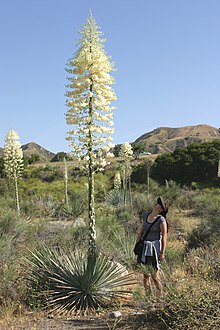Taxonomy
The taxonomy of Hesperoyucca is complex and somewhat controversial. [3] [7] Originally, in 1871, George Engelmann ranked "Hespero-Yucca" as a section of Yucca (with only one member, Yucca whipplei; all other Yucca species he placed in section Eu-Yucca, with three subgroups). In 1895 he revised his classification of Yucca, to four equal groups, of which Hesperoyucca was one. In 1876, John Gilbert Baker gave it the rank of subgenus; in 1892 he noted that it "had better be kept as a genus distinct from Yucca" (but actually retained the name Y. whippleii [sic]). [3]
Some authorities accept this as having erected the genus Hesperoyucca, but others credit this to William Trelease, who printed a taxonomic description in 1893, formally recognizing Hesperoyucca as being at the same rank as, but separate from, Yucca. [3] [8] It has taken recent DNA analysis to confirm that they are indeed genetically distinct from Yucca. [3]
The splitting of Hesperoyucca from Yucca is still not widely reflected in available literature or online (for example, the British Royal Botanic Gardens, Kew and the Royal Horticultural Society websites do not recognize the name as current). [9] [10]
This page is based on this
Wikipedia article Text is available under the
CC BY-SA 4.0 license; additional terms may apply.
Images, videos and audio are available under their respective licenses.
